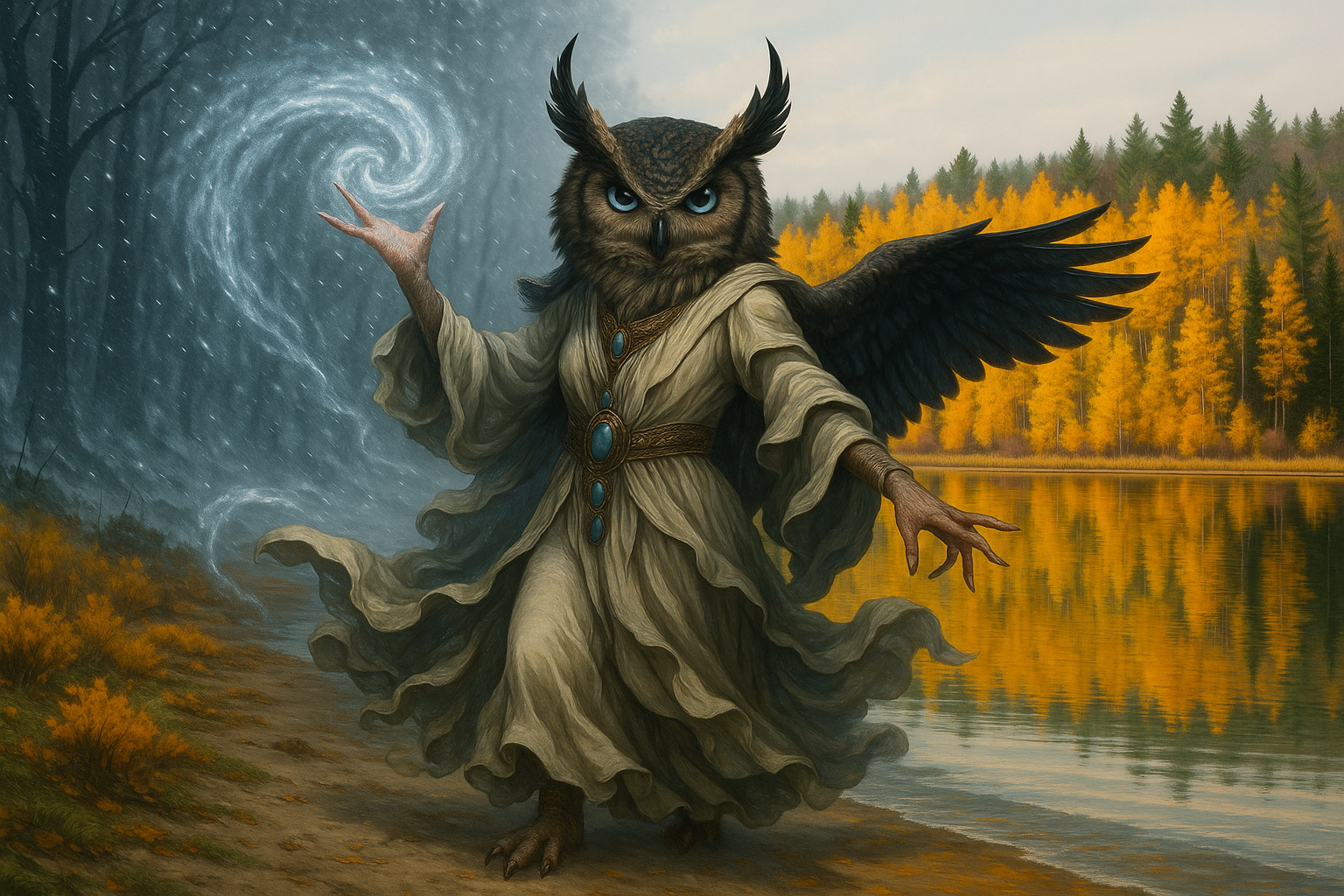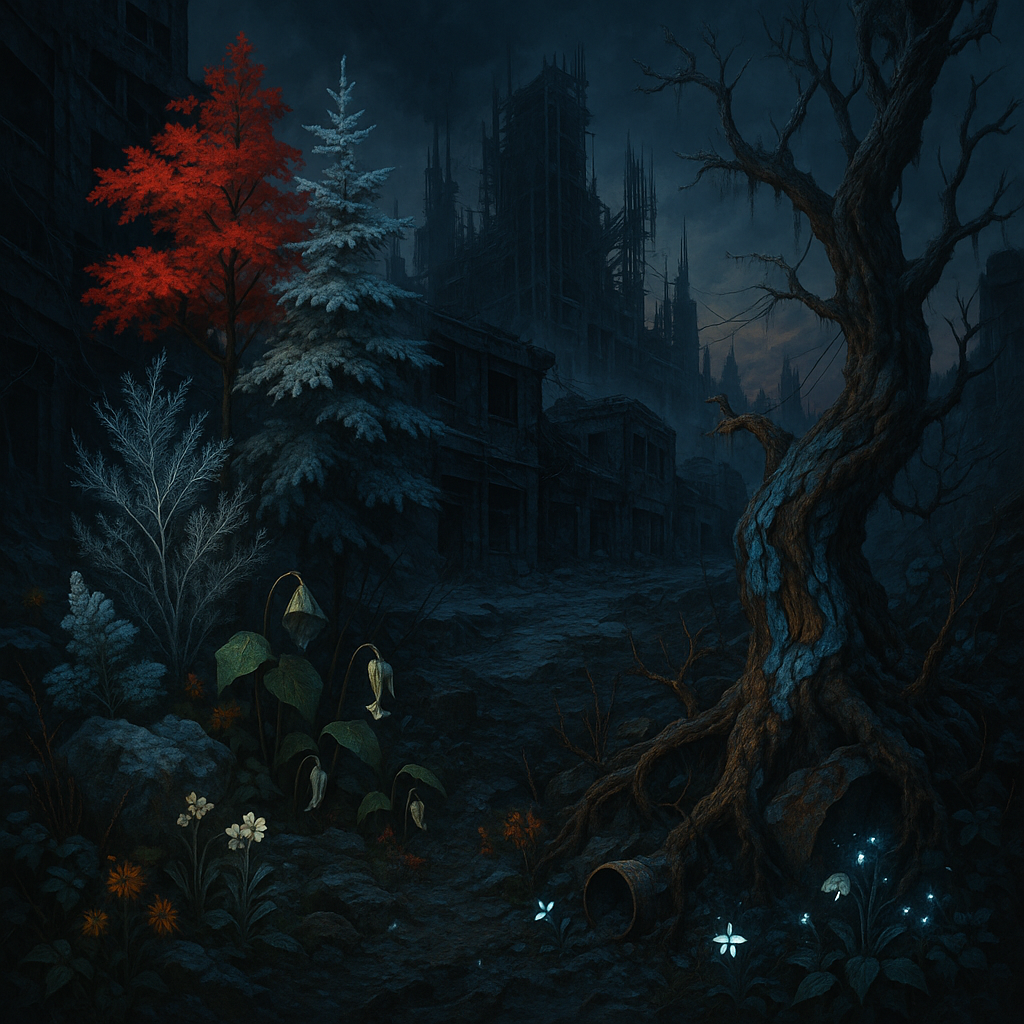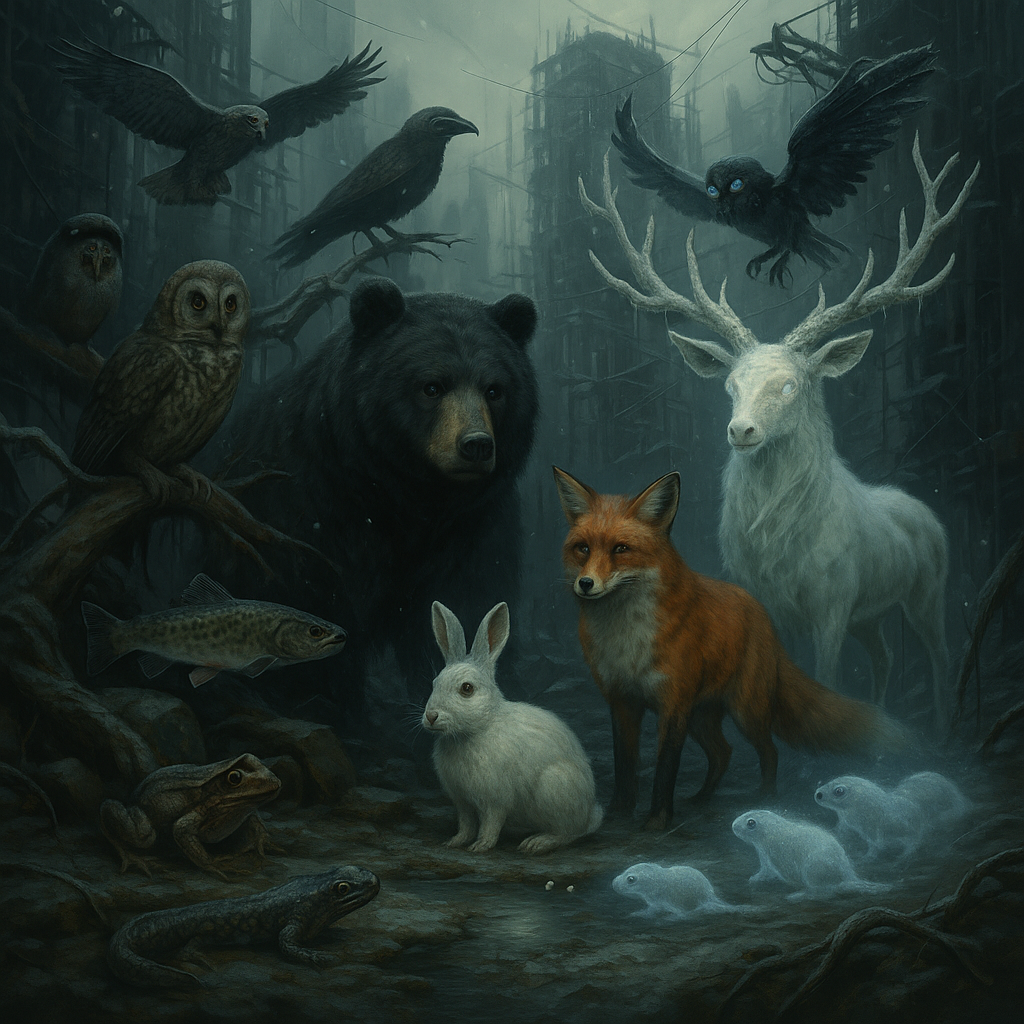Geography
Driftland is a high, wind-swept plateau located east of the lake’s inland sea and west of the old mountain lines, sitting like a weathered crown between crumbling wilderness and the shattered skeletons of former towns. Though not a mountain range in the true sense, its raised, uneven terrain—cut through with gullies, glacial ravines, and hanging falls—gives it the illusion of great heights. The area is notorious for its elevation and remoteness.
Its most dramatic geographic features include Inman Gulf, a steep chasm carved by ancient waters, and Rainbow Falls, a sheer cascade that drops nearly 100 feet into a roaring stone throat. The plateau is blanketed by thick deciduous and boreal forest, giving way to wetlands, bogs, and blackwater streams. Dozens of rivers, creeks, and tributaries are born here, flowing off the edge of the plateau like veins spilling into the lowlands.
Driftland is a place of raw, untouched beauty—icebound cliffs, frozen mist gardens, moss-hung tree canopies, and glassy pools hidden in glades of perpetual silence.

Ecosystem
Driftland's ecology is rugged and resilient, shaped by the extremes of water and weather. It supports a dense network of ecological zones—hardwood uplands, conifer bogs, and frost-laced wetlands—bound together by seasonal flooding and snowmelt.
The forests are dominated by sugar maple, red spruce, and balsam fir, while lowlands are thick with tamarack, hemlock, and ghost moss. Wildlife must be opportunistic and adaptive: bears dig deep dens beneath ridges, lynx stalk snowshoe hares through silent snowdrifts, and beavers build multi-level dams in icy streams.
The predator-prey balance is sharp, unforgiving. Survival here is not seasonal—it is constant. Apex predators include bobcats, fishers, and the elusive Frost-Wind Owls, birds so silent their wings do not stir even the snow.
The trees don’t sleep in the Driftlands—they endure. Every root grips frozen stone like a hand clinging to life, every creature carves its place in silence or vanishes beneath the snow. It’s not an ecosystem. It’s a test.
Ecosystem Cycles
The ecosystem moves in sharp, dramatic swings between seasons. The year is a war of endurance between the thaw and the freeze.
Winter (Dominant Season): NOV- APR. Driftlands is gripped by relentless snow for nearly half the year. Wildlife either hibernates, migrates, or adapts to extreme cold. Snowshoe hares turn white, bears go deep underground, and wolves prowl the fringes of frozen rivers.
Spring (Brief and Violent): APR-MAY. A sudden thaw turns snowpack into flash floods. Water crashes through gullies and gorges, shifting land, breaking beaver dams, and renewing wetland habitats. Migrating birds arrive in a fury of song before the next frost strikes.
Summer (Green and Insect-Ridden): JUN-JUL. A brief season of warmth and growth. Ferns explode from forest floors, amphibians swarm breeding pools, and predators gorge before the next freeze. Insects emerge in thick, stinging clouds.
Autumn (The Descent): AUG-SEP. Driftlands glows with fire-colored leaves, then dies quickly. First frost falls by early October, and within weeks the land returns to ice.
Climate
Driftland is among the coldest and snowiest regions in the eastern territories.
- Snowfall: Annual snow exceeds 200–300 inches, mostly due to the lake’s influence and amplified by Viriala’s magic.
- Temperature: Winters often drop below −10°F (−23°C summers rarely exceed 75°F (24°C).
- Precipitation: The area is drenched in both snow and summer rain, with heavy runoff feeding into nearby lowland systems.
- Fog & Wind: High winds whip across the plateau, often creating dangerous whiteouts. Freezing fogs are common and can form disorienting "hollows of blindness" where sound and direction are lost.
Natural Flora
- Sugar Maple, Red Spruce, Yellow Birch
- Mountain Ash, Ghost Pipe, Jack-in-the-Pulpit
- Frost-Lichen, which grows only on north-facing rocks where Viriala's touch lingers
- Snowbell Orchids, glowing faintly under moonlight
Dark-Touched Flora
- Whisperweed: Grows in frost pockets, silver-hued and constantly rustling even when there's no wind. Said to echo the final words of lost travelers.
- Crackbark Pine: These gnarled trees weep icy resin at night and produce fruit that never rots—dangerous, as consuming it may grant lucid dreams of Viriala... or freeze the mind.
Natural Fauna
- Black Bear, Bobcat, Red Fox, Snowshoe Hare, Brook Trout
- Raptors: Barred Owls, Northern Goshawks
- Amphibians: Spotted Salamanders, Wood Frogs
Dark-Touched Fauna
- Frost Voles: Semi-transparent rodents that glide silently over snow, trailing rime in their wake.
- Shivercrows: Large, skeletal crows with frostbitten wings and ice-blue eyes. Thought to be watchers or messengers for Viriala.
- Mist Elk: Pale, silent giants seen only in the hours before a major storm. Said to be living weather-spirits bound to the Drift-Sister.
Localized Phenomena
At the icy heart of the Driftlands lies an ancient presence—Viriala, the Drift-Sister, a Fey Sovereign of Ice and Stillness, whose dominion has lasted far longer than human memory. She is not a being of wrath, nor kindness, but of silence—of slow, inevitable erosion. Her domain begins beneath Rainbow Falls, where the waters hang suspended in defiance of gravity, never quite freezing, never truly flowing. Beneath the falls, legend claims, lies a hollow of mirrored ice that descends into the Deep White—her throne, her cradle, her grave.
Her influence threads through the entire plateau. It is not an invasion but an inheritance. The land remembers her, obeys her. And in return, it becomes unbound by natural law.
Phenomena attributed to her presence include:
- Mid-Summer Snowfalls: Without clouds, without warning, fine crystalline snow begins to fall—warm sunlight above, snow on the ground below. The flakes melt only after sundown. Locals say these are the Drift-Sister’s “sighs”—moments when she remembers the world before fire.
- Frozen Time Pockets: Glades and clearings where motion falters. A deer mid-leap, a leaf suspended mid-fall, a hunter’s breath stalled in the air. Some pockets last seconds. Others stretch for days. Step inside, and you may emerge weeks later—unchanged, but altered in ways you don’t yet understand.
- Whispers in Ice: Icicles creak with meaning. Frozen brooks murmur forgotten names. At times, voices—soft, brittle, mournful—can be heard just beyond the edges of hearing, always where frost thickens and no wind blows. Those who listen too long come away changed: some inspired, others hollowed.
- Perennial Frost Zones: Even in the height of summer, there are hollows where the frost never lifts. Flowers of ice bloom on black stone. Entire copses exist in permanent twilight, rimed with hoarfrost that never melts. Firewood cut here burns cold. Tools left overnight rust with frostbite.
- The Stillborn Storm: Rare, but catastrophic. An enormous wall of snow appears over the horizon—cloudless, silent, unmoving. Days may pass before it collapses, smothering everything beneath it. Survivors of such storms speak of seeing a woman in the gale—her body made of snow-glass, her mouth unmoving as her voice filled their skulls like pressure.
Viriala herself is never seen directly, but her signs are unmistakable. The land grows still before her touch, and even the bravest predators grow quiet. Old trees creak as if exhaling memories. Ice forms in lungs. The air smells of violets and old bone.
Some say she was once a mortal, a healer who tried to save the land and failed. Others claim she was always of the Dark—a cold soul who bargained with the night to preserve what could not be saved. Her worshippers, rare and shunned, leave offerings of bone and frostbitten flowers at frozen cairns, asking for dreams, not mercy.
Travelers who disappear in the Driftlands are sometimes found again—weeks, years, even decades later. They are never aged, never injured. Their clothes bear no wear. But their eyes are pale and full of snow. They do not speak. They simply stare—at fire, at motion, at anything that defies the stillness they now carry.
The people of Defiance do not speak her name aloud when the frost settles thick or when the falls begin to hum. They say she listens best when the world forgets how to move.
History
Before the Fall, the region now called the Driftlands was known officially as Tug Hill State Forest—a remote, protected zone prized by nature-lovers and winter sports enthusiasts. Hemmed in by ridgelines and drenched in snowfall, it was a place of solitude and personal retreat. Trails wound through thick hemlock and sugar maple, and deep in its heart lay Rainbow Falls, a veiled cascade hidden in glacial ravines. Local folklore—rarely written down—spoke of the Woman Beneath the Falls, a spirit who walked barefoot through snow without leaving prints. She brought frost early, they said, and whispered through frozen trees. Locals carved her sigils into bark and barnwood, small gestures of respect to keep the storms at bay.
Then came the Fall. As the world shattered, the Driftlands were swallowed whole by cold and silence. Satellite feeds and long-range drones showed entire valleys buried beneath unnatural blizzards. Hikers vanished mid-transmission. Rescue missions returned without their pilots. Entire caravans froze in place, bodies turned crystalline in upright posture. Survivors from those missions—rare though they were—spoke of unmoving things in the fog, and snow that bled like milk. Most chalked it up to trauma. A few knew better.
The plateau became a dead zone. Salvage crews marked it black on their charts. Its storms weren’t just weather—they were resistance. The Driftlands refused reclamation. Roads never stayed plowed. Batteries failed for no reason. Ice crept into sealed systems. Even the air held weight. The few who dared to settle in its shadow called it cursed, holy, or both.
It wasn’t until decades later, when the city of Defiance began rising in the northern lowlands, that human feet began to trespass again. The Others—mutants, exiles, Awakened, and the unaccepted—ventured toward the plateau not out of conquest, but necessity. They needed wood, water, medicinal mosses. They needed silence. They needed a place the rest of the world avoided.
At first, only scouts and desperate pilgrims climbed the snowline. They built bone markers to find their way back, etched with names of the lost and promises to return. Weather stations were anchored with fused stone and ancient tech to measure the impossible: how could wind scream without trees? Why did temperatures drop as if some ancient lung exhaled beneath the earth? Shrines appeared next—simple at first: a ring of stones, a braid of icicle-bone. Then more elaborate: frost-temples carved into frozen bark, hollowed cairns of tumbled rock with offerings of hair, teeth, and glass.
And always, stories returned. Of footsteps that vanished mid-trail. Of voices beneath the ice calling by name. Of a woman in the storm, watching from behind a sheet of falling snow. She never moves, they say—but blink, and she's closer.
Even now, no one dares build on the plateau itself. Not for fear of beasts or weather, but out of reverence. The Driftlands are not dead land—they are occupied. Some call it holy ground, a place where the Dark keeps its oldest covenants. Others say it's a testing place, where you go to prove your soul—or lose it.
Defiance claims the forest to the north—temperate, manageable, half-tamed—but the Driftlands remain sovereign. They rise each winter like a throne of ice. And those who climb too high without offering or purpose are rarely seen again… unless they return, eyes full of snow, untouched by time, bearing messages no one understands.
Some are mourned. Others are worshipped.
The old tales remain. Only now, they're no longer whispers. They're warnings. And they're true.
Every few years the Driftlands remember us, and a white wall rolls down the hills to smother Defiance in silence and ice. Roofs collapse, fires die, breath turns to blades in your throat. We lose people—always. But better the cold's mercy than the open wilds. Out there, you don’t freeze. You scream. And you get dragged off still screaming.









I love this article, the descriptions and how they impart character to the land are really good.
Thank you so much!